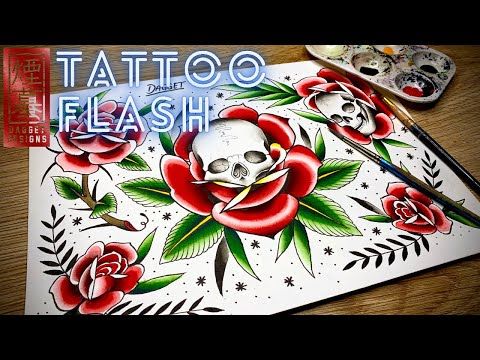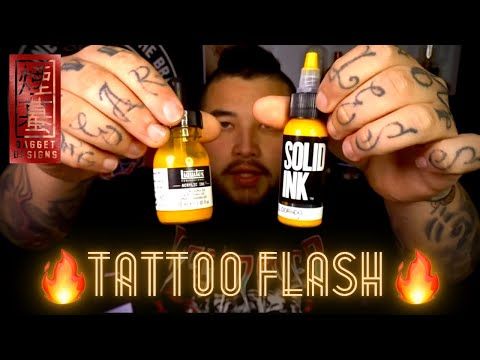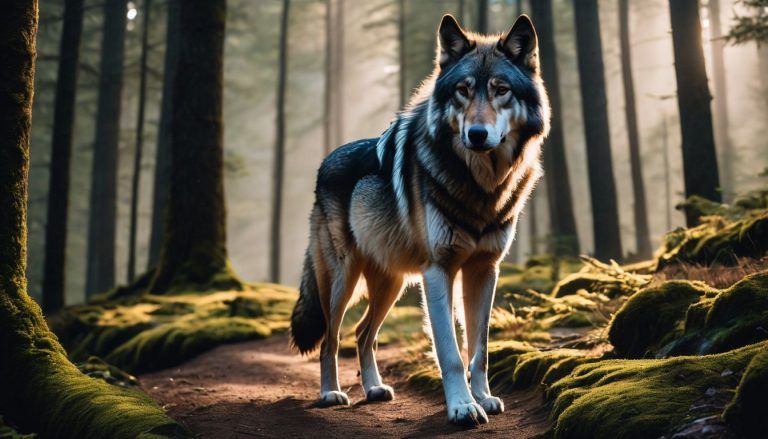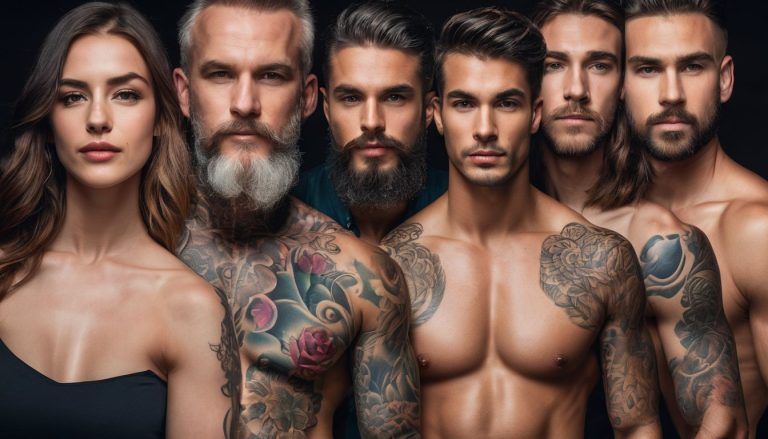The History and Significance of Tattoo Flash Designs
Are you curious about the colorful designs on the tattoo shop walls? Tattoo flash has been a staple in the world of ink since the late 1800s. This article dives into its rich history and why these images are more than just pretty pictures – they’re a vibrant catalog of body art’s past.
Keep reading to uncover fascinating stories etched in skin!
Key Takeaways
- Tattoo flash designs have been an essential part of the tattoo industry since the late 1800s, offering a catalog of pre-drawn traditional and modern styles for clients to choose from in shops.
- Influential flash artists like Sailor Jerry and Don Ed Hardy helped shape American traditional tattoos with their iconic motifs such as anchors, swallows, hearts, and pin-up girls.
- Flash Days are events at tattoo shops where clients can get affordable tattoos quickly by choosing from a selection of pre-drawn flash designs, continuing the tradition’s popularity.
- Variations of flash art include classic traditional designs that pay homage to tattooing’s history and custom pieces that reflect personal symbolism or style preferences.
- The use and accessibility of tattoo flash have expanded through online resources, broadening inspiration sources for clients and exposure opportunities for artists’ original work.
What is Tattoo Flash?
Tattoo flash refers to a set of pre-drawn tattoo designs that are displayed in tattoo shops for clients to choose from. These designs are often displayed on sheets or in books and can range from traditional and classic to more modern styles.
Flash days at tattoo shops also feature special events where customers can choose from a selection of flash designs for quick, affordable tattoos.
Definition and explanation
Tattoo flash refers to pre-drawn artwork that showcases potential tattoo designs. Artists display these illustrations on walls or in portfolios at their studios, providing a visual catalog for clients to browse and choose from.
Flash often includes popular motifs such as anchors, swallows, hearts, and other icons that have become staples of the traditional American tattoo style. The concept hinges on rapid selection; with flash art readily available, customers can quickly decide on a design without needing lengthy consultations or custom artwork.
These standardized images not only streamline the tattooing process but also ensure consistency in quality and style across different artists and shops. Flash days are special events where tattoos are offered at reduced prices based on the available flash designs—this tradition helps maintain the relevance of tattoo flash in modern parlance while celebrating its historical roots.
Moving beyond just static pictures, many contemporary tattooists adapt these time-honored pieces into unique creations for their clients, seamlessly blending history with personal expression.
Next up is a deeper look into how this art form is put into practice inside buzzing street shops worldwide.
How it is used
Tattoo flash is used as a reference for both tattoo artists and clients. Artists may use flash designs to create standardized tattoos quickly, while clients can browse through the available designs to choose their preferred tattoo.
Flash days at tattoo shops feature these pre-drawn designs, allowing customers to select from a wide range of options promptly. Additionally, street shop tattoos often rely on flash designs for rapid tattooing, making them an integral part of traditional tattoo culture.
Flash tattoos have a historical significance in American traditional tattoo style, with influences on imagery and motifs attributed to these standardized designs. Furthermore, vintage tattoo flash is often sought after by collectors and enthusiasts who value the cultural importance and artistic appeal of these classic designs.
Flash Days at tattoo shops
Tattoo shops often host “Flash Days,” during which they showcase a wide array of pre-drawn designs for clients to choose from quickly. These flash sheets, displayed on walls or in binders, offer clients a selection of ready-made tattoo options.
The tradition of Flash Days dates back to the early days of American tattooing and remains popular today, providing both artists and clients with a convenient starting point for custom work.
Clients can browse through various flash designs – ranging from traditional motifs like anchors and hearts to contemporary illustrations – giving them the opportunity to select a design that resonates with their personal style and preferences.
The History of Tattoo Flash
The history of tattoo flash designs dates back to the early 1900s with the emergence of American traditional tattoos. These designs were originally hand-drawn by tattoo artists and displayed in their shops as a way to showcase their work and provide inspiration for clients.
The popularity of flash designs grew during this time, ultimately leading to the development of iconic flash artists who played a significant role in shaping tattoo culture.
Origins of flash designs
Flash designs originated in the early 1900s, coinciding with the invention of the electric tattoo machine. These pre-drawn designs were a way for tattoo artists to quickly present ideas to their clients and maintain artistic limitations.
Icons like anchors, hearts, swallows, and pin-ups were popular among sailors during this period. Initially drawn on paper or cardboard, flash tattoos gained prominence as standardized designs that benefited both artists and clients.
The term “flash” itself comes from the practice of swiftly showcasing these predesigned options to customers. Over time, flash designs have become an intrinsic part of traditional American tattooing, influencing imagery and motifs commonly linked with this style.
Evolution and popularity
Flash tattoos have evolved over time, from their origins in the early 1900s to becoming a staple in modern tattoo culture. The popularity of flash designs has endured, with traditional motifs like anchors, hearts, and swallows remaining iconic symbols in the tattoo world.
These designs have not only persisted but also evolved to encompass a wide array of styles and subject matter, reflecting changing trends and artistic innovations within the industry.
The widespread popularity of flash tattoos can be attributed to their role as accessible entry points into the world of body art. Aspiring clients often gravitate towards these pre-drawn designs for their affordability and timeless appeal.
Famous flash artists
Some famous flash artists have left a significant mark on tattoo history, with their designs becoming iconic symbols in traditional tattooing. For instance, Norman Collins, also known as Sailor Jerry, is renowned for his classic American traditional tattoo designs.
His flash artwork often features bold lines, vibrant colors, and timeless motifs like swallows, anchors, and pin-up girls. Another influential figure is Bert Grimm, who contributed to shaping the visual language of old school tattoos with his nautical-themed flash designs.
These artists’ contributions continue to inspire contemporary tattoo artists and enthusiasts alike.
Moreover, Don Ed Hardy gained widespread recognition for his fusion of Japanese ukiyo-e art and American traditional style in his flash designs. His unique approach to blending cultural elements has had a lasting impact on the evolution of modern tattoo artistry.
The Significance of Tattoo Flash Designs
Tattoo flash designs have significant cultural and historical importance, influencing tattoo culture and connecting to the tradition of street shops. To learn more about the impact of tattoo flash on the art of body modification, read on.
Cultural and historical importance
Flash tattoos hold significant cultural and historical importance in the realm of tattooing. These pre-drawn designs, dating back to the early 1900s, have played a pivotal role in shaping American traditional tattoo styles.
They provided a standardized set of designs for both tattoo artists and clients, influencing the imagery and motifs commonly associated with this style. Furthermore, flash tattoos are deeply rooted in the history of American tattooing, representing an essential aspect of its evolution and popularity.
With their origins tied to the early days of American tattooing and their influence on imagery commonly associated with traditional tattoos, flash designs have left an indelible mark on tattoo culture.
Influence on tattoo culture
Tattoo flash has had a significant influence on tattoo culture, shaping the imagery and motifs commonly associated with American traditional tattoos. The standardized set of designs provided by flash has played a key role in establishing the visual language of this style, contributing to its timeless appeal.
Furthermore, flash tattoos have allowed for quick and efficient customer choices, making them an integral part of the tattooing process and contributing to their enduring popularity within tattoo culture.
The impact of tattoo flash is evident in how it has influenced street shops by providing readily available designs for both artists and clients. This influence has extended beyond traditional brick-and-mortar tattoo parlors to online resources that offer access to a wide array of flash designs.
Connection to street shops
Influence on tattoo culture has a direct connection to street shops, where flash designs are prominently displayed. Flash tattoos have historically been a staple of street shop offerings, providing clients with a wide range of pre-drawn options to choose from quickly.
These designs often reflect the cultural and historical significance associated with traditional tattoo art, contributing to the unique atmosphere and appeal of street shops. The influence of flash designs on tattoo culture is inherently linked to their presence in these local establishments, shaping the experience for both artists and clients alike.
Types of Tattoo Flash
There are different types of tattoo flash designs that people can choose from, including traditional designs, custom flash designs, and online flash resources. These designs provide a wide range of options for individuals looking to get inked with meaningful and unique artwork.
Traditional designs
Traditional tattoo flash designs are characterized by bold lines, solid colors, and iconic imagery such as hearts, anchors, swallows, and pin-ups. These classic designs have their roots in the early 20th century and are synonymous with American traditional tattooing.
They played a significant role in establishing the visual language of tattoos during that era. Traditional flash designs continue to be popular choices for those seeking timeless and iconic tattoos that pay homage to the rich history of tattoo culture.
Flash tattoos’ historical significance lies in their ability to provide a standardized set of designs for both tattoo artists and clients. The influence of traditional flash designs on American tattoo style is evident through the enduring popularity of these classic motifs and imagery associated with this style.
Custom flash designs
Custom flash designs offer a unique and personalized approach to traditional tattoo flash. These designs are specifically tailored to individual preferences and ideas, allowing clients to have a one-of-a-kind piece of art that reflects their personality and style.
With custom flash designs, tattoo artists work closely with clients to create original artwork that holds personal meaning or symbolism. This process not only enhances the connection between the client and their tattoo but also showcases the artistic talent of the tattooist.
Tattooists skilled in creating custom flash often draw inspiration from various sources such as nature, cultural symbols, or personal experiences to craft meaningful and visually striking designs.
Online flash resources
Many tattoo artists and enthusiasts turn to online resources for a wide range of flash designs. Websites and social media platforms feature virtual galleries showcasing a variety of tattoo flash, including traditional designs, custom creations, and contemporary artwork.
These online resources serve as valuable references for both clients seeking inspiration and tattoo artists looking to expand their repertoire. With just a few clicks, individuals can easily access an extensive collection of flash designs, offering endless possibilities for creating unique and personalized tattoos.
Online platforms also provide a convenient way for tattoo enthusiasts to purchase digital or print versions of flash designs directly from artists. This accessibility allows individuals to explore different styles and themes before consulting with their chosen artist, ultimately facilitating the design process.
Conclusion
In conclusion, tattoo flash designs have a rich history and cultural significance. They originated in the early 1900s and became a cornerstone of American traditional tattooing. Flash designs continue to influence tattoo culture and are an integral part of street shop traditions.
Understanding the evolution and impact of flash tattoos sheds light on their enduring relevance in the world of body art.
FAQs
1. What are tattoo flash designs?
Tattoo flash designs are pre-made pictures and sketches that show different tattoo ideas, found in galleries, books, and on sheets sold for people looking to get a tattoo.
2. How did tattoo flash art start?
The tradition of tattoo flash art began many years ago when artists created collections of designs shown on walls or in sketchbooks for customers to choose from quickly.
3. Can you buy your own custom tattoo flash?
Yes, if you want something unique, there are artists who create custom tattoo flash tailored just for your personal style and symbolism.
4. Why is it important to look at a tattoo reference book before getting inked?
Looking through a reference book can give you tons of ideas about tattoos because these books often have historic and classic flashes along with new trends.
5. Are tattoos just pictures or do they carry deeper meaning?
Many tattoos hold significant meanings; they’re symbols reflecting personal stories or traditions tied back to the history where each design has its own special interpretation.










